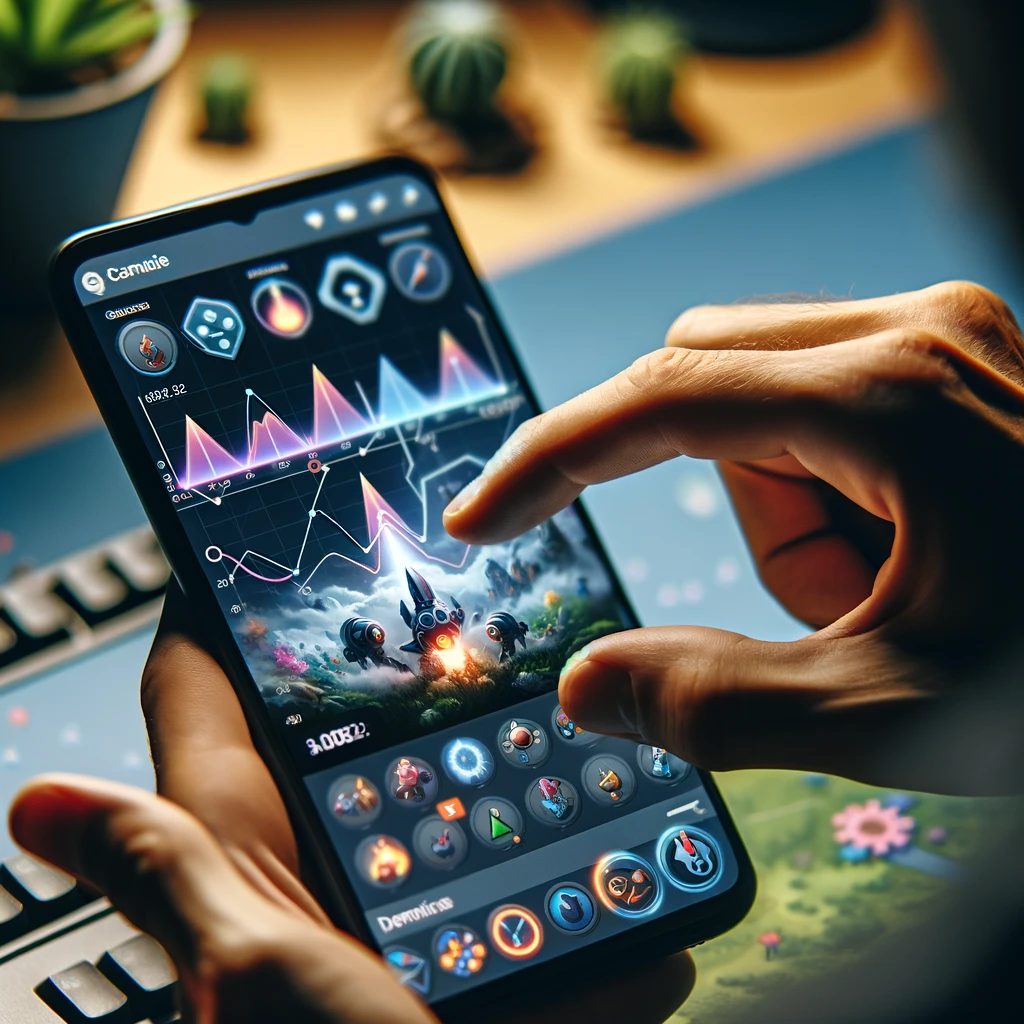Reading time: 9 minutes.
In today’s dynamic digital era, the mobile gaming industry has blossomed into a vibrant and diverse realm, offering endless entertainment options to millions worldwide. When it comes to designing a mobile game, a blend of art, technology, and user psychology, demands not only creativity but also a deep understanding of what captivates and retains players. With countless games vying for attention in app stores, standing out requires more than just a great idea; it requires a meticulous and thoughtful approach to game design.

This guide to designing a mobile game is crafted to demystify the complexities of mobile game creation, offering a roadmap to success in this competitive landscape. Whether you’re an aspiring indie developer or part of an established game studio, the principles outlined here will help you navigate through the critical aspects of game design, from conceptualization to post-launch management. We will delve into strategies for identifying and understanding your audience, creating engaging game mechanics, developing captivating game worlds, and implementing ethical monetization models, among other key elements.
Embark on this journey with us as we explore the essential steps and innovative approaches to create a mobile game that not only captures the imagination but also stands the test of time in the ever-evolving world of mobile gaming.
Designing a Mobile Game: Understanding Your Audience
The start to designing a mobile game begins with a deep understanding of your audience. Knowing who will play your game is pivotal in tailoring the gaming experience to meet their preferences and expectations. This involves researching and segmenting the market to identify your primary audience, be it casual gamers seeking quick entertainment, hardcore gamers looking for a challenge, or any other specific demographic.
Consider factors like age, gender, geographical location, and cultural nuances, which can significantly influence gaming preferences. For example, younger audiences might prefer fast-paced, visually vibrant games, while older players might lean towards puzzle-based, strategic games. Cultural considerations are equally important, as certain themes, characters, and storylines resonate differently across various cultures.
It’s also crucial to understand the technical proficiency of your audience. Are they seasoned gamers accustomed to complex mechanics, or are they more casual players who favor simplicity and ease of use? This knowledge informs the complexity of your game mechanics and controls, ensuring that your game is both accessible and engaging to your intended audience.

Remember, the goal is to create a game that not only attracts but also retains players by aligning with their preferences and playing habits. Thorough audience research and analysis are indispensable steps towards achieving this goal, setting a solid foundation for the subsequent stages of game development.
The Importance of Game Mechanics
At the core of any successful mobile game lies its game mechanics, the fundamental rules and systems that dictate how a game operates and how players interact with it. These mechanics are the building blocks that shape the player’s experience and are crucial in making a game both enjoyable and memorable. A well-designed game mechanic resonates with the player, creating a sense of challenge, engagement, and progression.
One of the key aspects of designing a mobile game is the game mechanics; this is the creation of a compelling core gameplay loop. This loop is the repetitive cycle of actions that players engage in, such as collecting resources, battling enemies, or solving puzzles. It’s essential that this loop is intrinsically rewarding and finely balanced to ensure that it remains engaging over time, encouraging players to return regularly.
Moreover, the mechanics should be intuitive yet deep, allowing new players to quickly grasp the basics while offering enough complexity to keep experienced players challenged. Balancing these elements requires careful planning and testing, ensuring that the game provides a satisfying blend of ease of entry and long-term depth. By mastering the art of game mechanics, developers can create a game that not only attracts players but also keeps them immersed in the game world, contributing significantly to the game’s longevity and success.
Creating an Engaging Game World
In the realm of mobile gaming, the creation of an engaging game world is pivotal to captivating your audience. This aspect transcends mere aesthetics; it involves weaving a tapestry of immersive narratives, vibrant visuals, and a cohesive theme that resonates with the player. Crafting a compelling story, even for the simplest of games, can significantly enhance the player’s emotional connection. The narrative becomes a driving force, motivating players to return and explore further.
The art style and visuals play a crucial role in defining the game’s identity. Whether you opt for a minimalist approach or detailed graphics, consistency in style is key to creating a visually appealing and coherent world. This aesthetic choice sets the tone and mood, enhancing the overall gaming experience. The sound design, often an overlooked aspect, is equally vital, adding depth and dimension to the game world. By seamlessly integrating narrative, visuals, and sound, developers can create a rich, immersive environment that not only entertains but also transcends the boundaries of mere gameplay, making the players feel like they are part of something larger and more enchanting.
Designing a Mobile Game: Monetization Strategies
In the intricate world of mobile game development, monetization strategies play a pivotal role in ensuring the financial success of a game while maintaining a positive player experience. The key is to strike a balance between generating revenue and keeping the game enjoyable and fair for all players.
Ethical monetization is crucial. Avoiding aggressive pay-to-win models not only respects the player’s experience but also builds long-term loyalty. Thoughtful implementation of in-app purchases, such as cosmetic items, special levels, or power-ups, can enhance the gameplay without giving an unfair advantage. Advertisement placement should be carefully considered, opting for non-intrusive methods like rewarded videos, which offer in-game bonuses for watching ads, thus creating a win-win scenario.

Subscriptions models and premium versions are also viable options. These models can offer players an ad-free experience, exclusive content, or special features, adding value to their spending. It’s important to ensure that spending feels rewarding to the player; this could be through exclusive content, customization options, or special gameplay features, enhancing the perceived value of purchases.
Engaging players in the development process through beta testing and early access programs can not only improve the game but also create a sense of investment and willingness to spend. A community-driven approach to monetization, where players feel their spending contributes to the game’s growth and improvement, often leads to more successful and ethical monetization.
Ultimately, the goal is to create a monetization model that feels like a natural part of the game, offering players meaningful choices and rewards, rather than being an intrusive or necessary hurdle for enjoyment.
Leveraging Technology and Trends
In the realm of mobile gaming, successfully leveraging technology and trends can be a decisive factor in setting your game apart. Mobile devices offer a plethora of unique features that can transform the gaming experience. Innovations like touchscreen controls, augmented reality (AR), and gyroscopic elements open doors to new kinds of interactive experiences that are distinctively tailored for mobile platforms. These features, when integrated thoughtfully, can make gameplay more intuitive and immersive, thereby resonating strongly with players.
Keeping abreast of current trends is equally vital. The mobile gaming industry is rapidly evolving, with new trends emerging constantly. It’s important to distinguish between fleeting fads and lasting shifts in gaming preferences. Incorporating current trends, such as social gaming elements or live events, can greatly enhance engagement and relevance, but they should align with your game’s core concept and add genuine value to the player experience. In essence, the judicious use of mobile-specific technologies and trends can significantly elevate the appeal and success of your mobile game.
Community and Player Feedback when Designing a Mobile Game
Building a vibrant community and listening to player feedback are indispensable aspects of designing the perfect mobile game. Creating a game isn’t just about the initial launch; it’s about nurturing an ongoing relationship with your players. A strong, engaged community acts as the backbone of this relationship, offering invaluable insights, fostering loyalty, and even helping to market the game through word-of-mouth.
Encouraging player interaction is key. Utilize social media platforms, dedicated forums, and in-game communication tools to create spaces where players can connect, share experiences, and provide feedback. This engagement creates a sense of belonging among players, making them feel like part of the game’s journey.
Actively listening to player feedback is equally crucial. It’s not just about gathering opinions; it’s about acting on them. Regular updates, which address player concerns and suggestions, demonstrate that you value their input, leading to improved player satisfaction and retention. Remember, feedback isn’t just about identifying issues; it’s a window into the player’s experience, offering a roadmap for enhancements that can keep your game fresh, exciting, and aligned with your players’ evolving preferences.
Testing and Optimization
Testing and Optimization form the bedrock of successful mobile game development, a phase where meticulous scrutiny meets relentless refinement. The process begins with rigorous testing, an indispensable practice that ensures your game is not only bug-free but also delivers the intended user experience. This stage encompasses a wide array of tests, from functionality and usability to compatibility and performance, each uncovering potential issues that could impact the player’s journey. It’s essential to test across various devices and platforms, considering the vast diversity in mobile hardware and screen sizes. This guarantees a smooth, consistent gaming experience for all players, regardless of their device.
Performance optimization is equally crucial. A game that lags or crashes frequently is a surefire way to lose players. Developers must strive to optimize code, graphics, and other elements to ensure the game runs fluidly across a spectrum of devices, particularly keeping in mind the limitations of lower-end models. This balance of high performance and broad accessibility is key to capturing and retaining a wide audience in the competitive mobile gaming market. Remember, a game that plays well is a game that stays well-loved.
Designing a Mobile Game: Marketing and Launch
In the realm of designing a mobile game, marketing and launching your game is as crucial as the game design itself. It’s a pivotal phase where the art of captivating storytelling meets strategic planning. A successful marketing campaign begins well before the game hits the app store, creating a buzz that draws potential players. This involves crafting compelling trailers that showcase the essence of your game, engaging with audiences on social media to build a community, and forming partnerships with influencers who can amplify your reach.

App store optimization (ASO) is another critical aspect, ensuring your game ranks high in search results and catches the eye with an attractive icon and screenshots. The launch day is just the starting line; maintaining momentum post-launch is key. Regular updates, responding to player feedback, and ongoing marketing efforts keep the game relevant. Events, collaborations, and content updates can reinvigorate interest and retain existing players. In this ever-competitive market, the combination of a well-executed launch and robust, continuous marketing can make the difference between a game that fades into obscurity and one that becomes a lasting hit.
Designing a mobile game is a blend of art, science, and business. By focusing on your audience, perfecting game mechanics, creating an engaging world, implementing ethical monetization, leveraging technology, building a community, testing rigorously, and marketing effectively, you can develop a mobile game that stands out in the crowded app market. Remember, the journey doesn’t end at launch; continual improvement and adaptation are key to long-term success.





